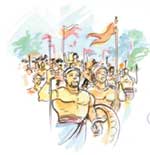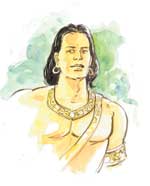|
This
article is part of a continuing series on the ‘Mahavamsa’,
the recorded chronicle of Sri Lankan history
King Valagamba
 King Lajji-Tissa reconciled with the priests and began to follow
Buddhist principles. The doors of the palace were open to the
priests. Alms were offered to them. The king started renovating
the Buddhist shrines. He leveled the area between Ruwanveli Chetiya
and Thuparamaya. He spent a lot of money on this. He built a great
hall for the Thuparamaya and offered it to the Sangha.
King Lajji-Tissa reconciled with the priests and began to follow
Buddhist principles. The doors of the palace were open to the
priests. Alms were offered to them. The king started renovating
the Buddhist shrines. He leveled the area between Ruwanveli Chetiya
and Thuparamaya. He spent a lot of money on this. He built a great
hall for the Thuparamaya and offered it to the Sangha.-
After doing many meritorious deeds he won the goodwill of the
people. He ruled the country for a period of nine years and eight
months. He passed away in 109 BC. The next to ascend the throne
was his brother Khallata-Naga. By this time, there had arisen
a quarrel among the children of king Saddha-Tissa, who were residing
in Dighavapi. The youngest son, Valagamba was living in a distant
village, in disguise.
-
Though a righteous king, Khallata-Naga was not successful as a
ruler. He repaired the Lohapasada and built a wall around Ruwanveli
Chetiya. He was quite close to the people, who loved him much.
He tried his best to carry on a righteous rule. He trusted his
ministers a little too much and decentralized power. This led
to his downfall. There were the loyal and the not so loyal ones
among his ministers. He ruled the country for six years.
-
There was a minister named Maha Ratthaka, who had won the heart
of the king. He was very shrewd. He conspired against the king.
He secretly killed the king. The other ministers protested. They
thought they must go in search of Valagamba, who was the only
one qualified to be king. He was the last in the line of King
Saddh-Tissa. The ministers went to far off villages in search
of the prince and managed to find him, although he was living
in disguise. The ministers had a long discussion with the prince
and even planned to kill Maharatthaka.
 They arrived at a decision. When they came back to Anuradhapura,
the evil Maharatthaka was killed. Valagamba became king in 103
BC. The queen of his deceased brother Khallata-Naga, was made
his queen. She was Queen Anula and the mother of a child by then.
This son was named Mahasilu Mahatissa. King Valagamba adopted
him as his son.
They arrived at a decision. When they came back to Anuradhapura,
the evil Maharatthaka was killed. Valagamba became king in 103
BC. The queen of his deceased brother Khallata-Naga, was made
his queen. She was Queen Anula and the mother of a child by then.
This son was named Mahasilu Mahatissa. King Valagamba adopted
him as his son.-
By this time, the power of the Tamils had spread over a large
area in the North of Anuradhapura. The people in this part, used
to accept whoever came to power, whether it be Sinhala or Tamil.
King Valagamba tried to win the hearts of both Sinhala and Tamil
people and rule justly. But unfortunately, he could rule only
for six months. Two armies, one from the north and the other from
the south, marched against him.
-
These armies were marching towards Anuradhapura. From the south,
it was a Brahmin named Tissa and from the north came seven Tamil
commanders. King Valagamba thought of a very good plan. He wanted
these two armies to fight each other. The Brahmin Tissa had sent
a threatening letter to the king saying that he will destroy the
city of Anuradhapura, if he was not made king. The king sent a
fitting reply. His reply read thus. “I agree to confer kingship
on you provided you save the country from enemies, before they
conquer us”.
-
It went on to say, “O Tissa, decide soon. Already a huge
Tamil army has landed in Mantota. They are getting ready to set
fire to all the villages on their way, ruin everything and then
reach Anuradhapura. Quite a number of our people have already
suffered under them. Organise your army and march forward to fight.
You must win the battle to receive kingship in Anuradhapura”.
The Brahmin Tissa was happy to receive this message. He marched
with his army to Mantota.
|